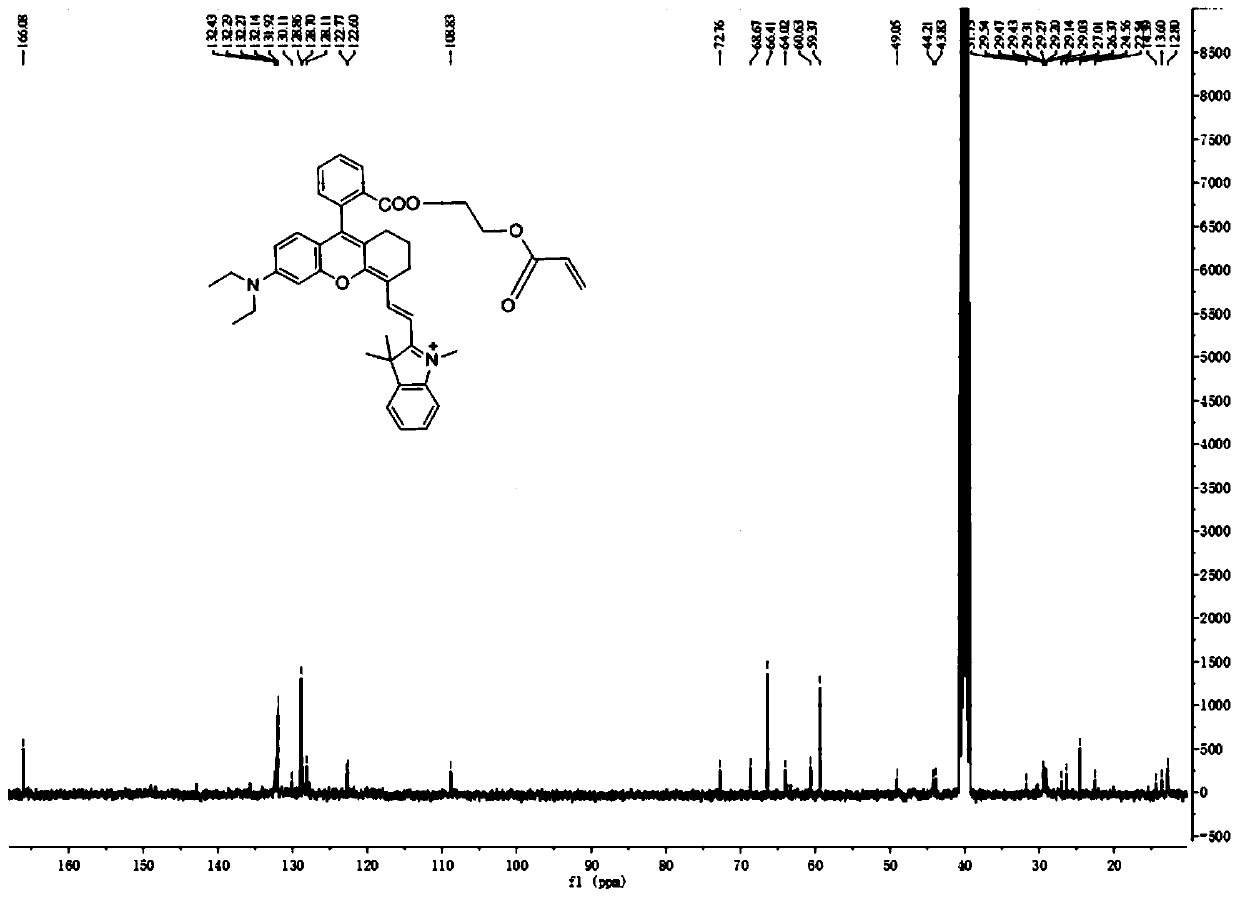Polymer fluorescent probe for detecting viscosity as well as preparation method and application thereof
A fluorescent probe and polymer technology, applied in fluorescence/phosphorescence, chemical instruments and methods, analytical materials, etc., can solve problems such as difficult to make optical accessories, restrict automatic detection, pollute the system to be tested, etc., and achieve good optical stability Sexuality, easy physical and chemical properties, high sensitivity effect
- Summary
- Abstract
- Description
- Claims
- Application Information
AI Technical Summary
Problems solved by technology
Method used
Image
Examples
Embodiment 1
[0061] Embodiment 1: the synthesis of macromolecule fluorescent probe
[0062] (1) Synthesis of compound ③
[0063] Weigh 0.6267g (2mmol) of 4-diethylamino ketoacid (①) and 0.3926g (4mmol) of cyclohexanone (②), dissolve in 5ml of concentrated sulfuric acid, heat at 85°C for 24h, and stop the reaction. Add the reacted solution dropwise to 300ml of distilled water for dilution, then add perchloric acid dropwise to the diluted system to produce precipitation, stop adding perchloric acid when no precipitation occurs, and then decompress Filter, and wash the acid on the surface of the product with distilled water in the state of suction filtration. The washed product was placed in a vacuum drying oven at room temperature and vacuum dried for 24 hours to obtain a pure and dry compound ③. Compound ③ is a green solid. The yield was 70%.
[0064]
[0065] (2) Synthesis of compound ⑤
[0066] Take 0.5g (1.3mmol) of compound ③ and 0.2673g (1.3mmol) of Fisher's aldehyde (④), disso...
Embodiment 2
[0078] Embodiment 2: Fluorescence spectra of fluorescent probes in different viscosity systems
[0079] A test mother solution of dimethyl sulfoxide (DMSO) with a concentration of 20 mg / ml of the polymer fluorescent probe obtained in Example 1 was prepared for use.
[0080] In the test solution, take 2ml solvents of glycerol and methanol in different ratios (glycerol:methanol=0:10, 1:9, 2:8, 3:7, 4:6, 5:5, 6:4, 7:3 , 8:2, 9:1, 10:0), then add the probe mother solution (final concentration is 0.2mg / ml), carry out fluorescence scanning (excitation wavelength 510nm, detection band 530-750nm), measure the relative Fluorescence intensity, such as image 3 shown. Depend on image 3 It can be seen that with the increase of solvent viscosity, the relative fluorescence intensity becomes stronger.
Embodiment 3
[0081] Example 3: Imaging of fluorescent probes in cervical cancer cells
[0082] A test mother solution of dimethyl sulfoxide (DMSO) with a concentration of 100 μg / ml of the polymer fluorescent probe obtained in Example 1 was prepared for use.
[0083] Inoculate appropriate density of Hela cells into sterilized 35mm imaging culture dishes in CO 2 Incubator (37°C, 5% CO 2 ), after the cells adhered to the wall, the first group added 40 μL of high molecular viscosity fluorescent probes and incubated for half an hour before biological imaging (single photon imaging: excitation wavelength: 561nm, emission wavelength: 570-620nm); the second group Add 10 μM viscosity stimulant monensin (Monensin) first, then add 40 μL polymer fluorescent probe after 40 minutes, incubate for half an hour and perform biological imaging; the third group first add 10 μM viscosity stimulant nystatin (Nystatin), After 40 minutes, add 40 μL of high molecular viscosity fluorescent probes, incubate for ha...
PUM
 Login to View More
Login to View More Abstract
Description
Claims
Application Information
 Login to View More
Login to View More - R&D Engineer
- R&D Manager
- IP Professional
- Industry Leading Data Capabilities
- Powerful AI technology
- Patent DNA Extraction
Browse by: Latest US Patents, China's latest patents, Technical Efficacy Thesaurus, Application Domain, Technology Topic, Popular Technical Reports.
© 2024 PatSnap. All rights reserved.Legal|Privacy policy|Modern Slavery Act Transparency Statement|Sitemap|About US| Contact US: help@patsnap.com










